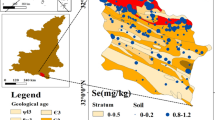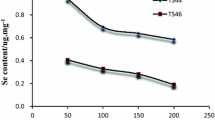Abstract
Selenium (Se) is an essential trace element for humans but non-essential for plants. Selenium bioavailability depends on selenium forms in soil. Selenium contents may vary with the source of parent material, and pedogenesis controls its vertical distribution. The objectives of this study were to determine the variation in Se fractions with parent material and pedogenesis in Pothwar uplands of Pakistan. Triplicate soil profiles at different development stages from selected parent materials (sandstone, alluvium, loess, and shale) were sampled at different genetic horizons level. The soils were characterized for pH, dissolved organic carbon, total organic carbon, dithionite extractable amorphous iron, and cation exchange capacity. Soil selenium was fractioned into ion-exchangeable, metal oxides, organic, humic, sulfide, and residual selenium. Selenium in the soil extract was measured using HVG-AAS after centrifuge and passing through a 0.45-μm cellulose free filter. The distribution of total selenium content and selenium fractions varied with the type of parent material and soil genesis. Total selenium contents differed significantly across the different parent material. The highest total selenium was in shale followed by loess, alluvium, and sandstone, respectively. Exchangeable ion, metal oxides, and organic matter selenium were more in loess or the same level as of shale. Evaluation of the distribution of selenium fractions enabled us to estimate the occurrence of potential selenium deficiency and toxicity to humans and animals based on the parent materials and pedogenesis.








Similar content being viewed by others
References
Amin R, Ikram M (2007) Keys to soils of punjab and sindh. Ministry of Food Agriculture and Livestock, Government of Pakistan. 121 pp
Armstrong JA, Parnell J, Bullock LA, Perez M, Boyce AJ, Feldmann J (2018) Tellurium, selenium and cobalt enrichment in Neoproterozoic black shales, Gwna Group, UK: deep marine trace element enrichment during the Second Great Oxygenation Event. Terra Nova 30:244–253. https://doi.org/10.1111/ter.12331
Bakather OY, Kayvani FA, Khraisheh M, Nasser MS, Atieh MA (2017) Enhanced adsorption of selenium ions from aqueous solution using iron oxide impregnated carbon nanotubes. Bioinorg Chem Appl 2017:4323619–4323612. https://doi.org/10.1155/2017/4323619
Bullock LA, Parnell J, Perez M, Armstrong JG, Feldmann J, Boyce AJ (2018) High selenium in the Carboniferous coal measures of Northumberland, North East England. Int J Coal Geol 195:61–74. https://doi.org/10.1016/j.coal.2018.05.007
Chi FH, Amy GL (2004) Kinetic study on the sorption of dissolved natural organic matter onto different aquifer materials: the effect of hydrophobiciy and functional groups. J Colloid Interface Sci 274(2004):380–391. https://doi.org/10.1016/j.jcis.2003.12.049
Das S, Hendry MJ, Essilfie-Dughan J (2013) Adsorption of selenate onto ferrihydrite, goethite, and lepidocrocite under neutral pH conditions. Appl Geochem 28:185–193. https://doi.org/10.1016/j.apgeochem.2012.10.026
Donovan JJ, Ziemkiewicz PF (2013) Selenium adsorption onto iron oxide layers beneath coal-mine overburden spoil. J Environ Qual 42:1402–1411. https://doi.org/10.2134/jeq2012.0500
Fan J, Zeng Y, Sun J (2018) The transformation and migration of selenium in soil under different Eh conditions. J Soils Sediments 18:2935–2947. https://doi.org/10.1007/s11368-018-1980-9
Hagrova I, Zemberyoua M, Bajcan D (2005) Sequential and single step extraction procedure used for fractionation of selenium in soil samples. Chem Pap 59:93–98
Imran M, Akhtar MS, Hassan S, Khan KS, Khalid A, Mehmood A, Rukh S (2015) Distribution of selenite and selenate with weathering in various parent materials. Asian J Chem 27:4417–4424. https://doi.org/10.14233/ajchem.2015.19152
Imran M, Akhtar MS, Khan KS, Khalid A, Mehmood A, Rukh S, Nazeer G, Manzoor R (2016) Total and extractable soil selenium contents variation within and across the parent materials. Int Network Nat Sci 9:175–186
Jackson ML, Lim CH, Zelazny LW (1986) Oxides, hydroxides and aluminosilicates. In: Klute A (ed) Methods of soil analysis. Part 1, vol 9. Agronomy Society of America, Madison 101 pp
Kim YJ, Yuan K, Ellis BR, Becker U (2017) Redox reactions of selenium as catalyzed by magnetite: lessons learned from using electrochemistry and spectroscopic methods. Geochim Cosmochim Acta 199:304–323. https://doi.org/10.1016/j.gca.2016.10.039
Kulp TR, Pratt LM (2004) Speciation and weathering of selenium in upper cretaceous chalk and shale from South Dakota and Wyoming, USA. Geochim Cosmochim Acta 68:3687–3701. https://doi.org/10.1016/j.gca.2004.03.008
Kurokawa S, Berry MJ (2013) Selenium. Role of the essential metalloid in health. Metal Ions Life Sci 13:499–534. https://doi.org/10.1007/978-94-007-7500-8_16
Li Z, Liang D, Peng Q, Cui Z, Huang J, Lin Z (2017) Interaction between selenium and soil organic matter and its impact on soil selenium bioavailability: a review. Geoderma. 295:69–79. https://doi.org/10.1016/j.geoderma.2017.02.019
Loeppert RH, Hallmark CT, Koshy MM (1984) Routine procedure for rapid determination of soil carbonates. Soil Sci Soc Am J 48:1030–1033
Lopes G, Avila FW, Guilherme LRG (2017) Selenium behavior in the soil environment and its implication for human health. Cienc Agrotecnol 41(6):605–615. https://doi.org/10.1590/1413-70542017416000517
Matamoros-Veloza A, Newton RJ, Benning LG (2011) What controls selenium release during shale weathering? Appl Geochem 26:222–226. https://doi.org/10.1016/j.apgeochem.2011.03.109
Mayorga IC, Astilleros JM, Fernández-Díaz L (2019) Precipitation of CaCO3 polymorphs from aqueous solutions: the role of pH and sulphate groups. Minerals 9(3):178
Mclean EO (1982) Soil pH and lime requirement. In: Page AL (ed) Methods of soil analysis. Part II, Chemical and microbiological properties. American Society of Agronomy, Madison, pp 199–244
Mehmood A, Akhtar MS, Imran M, Rukh S (2018) Soil apatite loss rate across different parent materials. Geoderma. 310:218–229. https://doi.org/10.1016/j.geoderma.2017.09.036
Mehra OP, Jackson ML (1960) Iron oxide removal from soil and clays by dithionite-citrate buffered with sodium bicarbonate. Clay Miner 7:317–327
Natasha MS, Niazi NK, Khalid S, Murtaza B, Bibi I, Rashid MI (2018) A critical review of selenium biogeochemical behavior in soil-plant system with an inference to human health. Environ Pollut 234:915–934
Nelson DW, Sommers LE (1982) Organic matter. In: Page AL, Miller RH, Keeney DR (eds) Methods of soil analysis. Part II, Chemical and microbiological properties. American Society of Agronomy, Madison, pp 574–577
Parnell J, Brolly C, Spinks S, Bowden S (2016) Selenium enrichment in Carboniferous Shales, Britain and Ireland: problem or opportunity for shale gas extraction? Appl Geochem 66:82–87
Parnell J, Bullock L, Armstrong J, Perez M (2018) Liberation of selenium from alteration of the Bowland shale formation: evidence from the mam tor landslide. Q J Eng Geol Hydrogeol 51:503–508. https://doi.org/10.1144/qjegh2018-026
Qin HB, Zhu JM, Liang L, Wang MS, Su H (2013) The bioavailability of selenium and risk assessment for human selenium poisoning in high-Se areas, China. Environ Int 52:66–74. https://doi.org/10.1016/j.envint.2012.12.003
Ren H, Yang R (2014) Distribution and controlling factors of selenium in weathered soil in Kaiyang county, southwest China. Chin J Geochem 33:300–309. https://doi.org/10.1007/s11631-014-0691-1
Santos AC, Pereira MG, Anjos LHC, Bernini TA, Cooper M (2016) Genesis of soils formed from mafic igneous rock in the Atlantic Forest environment. Rev Bras Ci Solo 40:e0150056. https://doi.org/10.1590/18069657rbcs20150056
SAS Institute Inc (2002) SAS/STATR software version 9.4 system for Windows,
Smažíková P, Praus L, Száková J, Tremlová J, Hanč A, Tlustoš P (2019) The effect of organic matter rich amendments on selenium mobility in soil. Pedosphere 29(6):740–751. https://doi.org/10.1016/S1002-0160(17)60444-2
Supriatin S, Weng L, Comans RNJ (2016) Selenium-rich dissolved organic matter determines selenium uptake in wheat grown on low-selenium arable land soils. Plant Soil:1–22. https://doi.org/10.1007/s11104-016-2900-7
Walkley A (1947) A critical examination of a rapid method for determining soil organic carbon in soils: Effect of variations in digestion conditions and inorganic soil constituents. J Soil Sci 63:251–263. https://doi.org/10.14202/vetworld.2013.963-967
Wang TH, Chiang CL, Wang CF (2015) The correlation between selenium adsorption and the mineral and chemical composition of Taiwan local granite samples. KIT Scientific Publishing, Germany
Wang MK, Cui ZW, Xue MY, Peng Q, Zhou F, Wang D, Dinh QT, Liu YX, Liang DL (2019) Assessing the uptake of selenium from naturally enriched soils by maize (Zea mays L.) using diffusive gradients in thin-films technique (DGT) and traditional extractions. Sci Total Environ 689:1–9. https://doi.org/10.1016/j.scitotenv.2019.06.346
**ao K, Lu L, Tang J, Chen H, Li D, Liu Y (2020) Parent material modulates land use effects on soil selenium bioavailability in a selenium-enriched region of southwest China. Geoderma 376:114554. https://doi.org/10.1016/j.geoderma.2020.114554
**ng K, Zhou S, Wu X, Zhu Y, Kong J, Shao T, Tao X (2015) Concentrations and characteristics of selenium in soil samples from Dashan Region, a selenium-enriched area in China Soil Sci. Plant Nutr 61:889–897. https://doi.org/10.1080/00380768.2015.1075363
Yang Q, Hou QY, Gu QB et al (2016) Study of geochemical characteristics and influencing factors of soil selenium in the typical soil profiles in Wuming County of Guangxi[J]. Geoscience 30(2):455–462
Yatoo MI, Saxena A, Deepa PM, Habeab BP, Devi S, Jatav RS, Dimri U (2013) Role of Trace elements in animals: a review. Vet World 6(12):963–967
Author information
Authors and Affiliations
Corresponding author
Additional information
Responsible Editor: Stefan Grab
Appendix
Appendix
Rights and permissions
About this article
Cite this article
Imran, M., Akhtar, M.S., Mehmood, A. et al. Soil selenium transformation across different parent materials in Pothwar uplands of Pakistan. Arab J Geosci 13, 1098 (2020). https://doi.org/10.1007/s12517-020-06111-1
Received:
Accepted:
Published:
DOI: https://doi.org/10.1007/s12517-020-06111-1




